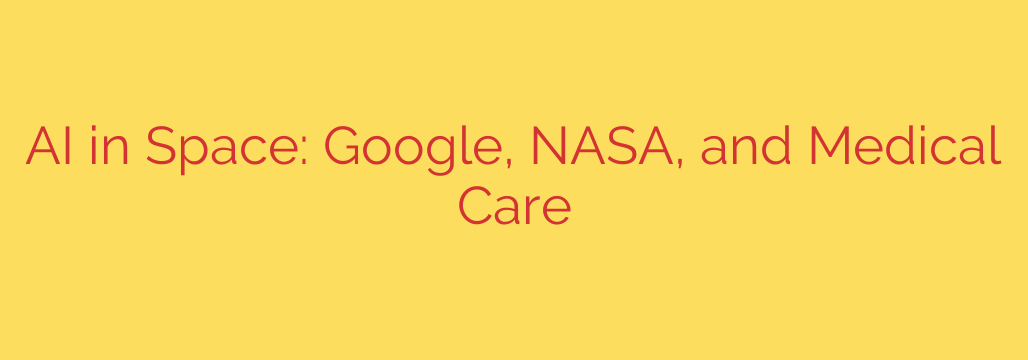
AI in Space: How NASA and Google Are Revolutionizing Astronaut Healthcare
As humanity sets its sights on long-duration missions to the Moon, Mars, and beyond, we face unprecedented challenges. While rocket propulsion and life support systems often steal the spotlight, a more subtle but equally critical obstacle remains: how do we provide medical care to astronauts when Earth is millions of miles away? A groundbreaking collaboration is tackling this problem head-on, using artificial intelligence to create a virtual medical expert in the void of space.
The solution is not just vital for future explorers but also holds immense promise for improving healthcare right here on Earth.
The Tyranny of Distance: Medical Emergencies in Deep Space
On the International Space Station (ISS), which orbits just a few hundred miles above Earth, astronauts have near-instant communication with Mission Control and a team of flight surgeons. If a serious medical issue arises, an emergency return to Earth is a viable, albeit complex, option.
However, a mission to Mars changes everything.
The immense distance means communication delays can be as long as 20 minutes each way. Imagine an astronaut suffering a medical emergency. They cannot simply video-call a doctor for real-time guidance. A 40-minute round-trip for a single question and answer is untenable in a crisis. This reality demands a new level of medical autonomy, where the crew can diagnose and treat illnesses independently.
A Pioneering Partnership for Autonomous Care
To solve this challenge, NASA has partnered with tech leaders to develop a sophisticated AI-powered diagnostic system. This system is designed to act as an onboard medical expert, empowering astronauts—who are highly trained but not always medical specialists—to manage complex health issues.
The core of this technology revolves around using machine learning and computer vision to analyze medical data collected in space. One of the primary applications is in interpreting ultrasound scans. Ultrasounds are non-invasive, versatile, and relatively compact, making them ideal for space missions. However, interpreting the images correctly requires extensive training.
This is where AI excels. An astronaut can perform an ultrasound on themselves or a crewmate, and the AI system can:
- Analyze the images in real time to check for abnormalities.
- Compare the scan against a vast database of healthy and pathological images.
- Identify potential conditions, from kidney stones to a collapsed lung.
- Provide step-by-step guidance on how to position the ultrasound probe correctly to get a clear diagnostic image.
This technology effectively places the expertise of a seasoned radiologist into the hands of the astronaut crew, bridging the gap created by the communication lag.
How AI Becomes a Virtual Doctor in Space
The system works by training AI models on thousands of ultrasound images. By learning to recognize patterns associated with various medical conditions, the AI can achieve a high degree of diagnostic accuracy. This isn’t just about identifying a problem; it’s about empowering non-medical personnel to perform a specialist’s task.
For astronauts, this means they can confidently use advanced medical tools to gather critical data. The AI doesn’t just deliver a diagnosis; it guides the user, confirming that they are scanning the correct organ and capturing the necessary information. This fusion of human action and AI analysis ensures that the medical process is both reliable and effective, even without a doctor present.
Benefits Beyond the Stars: Earthly Applications of Space AI
While developed for the extreme environment of space, this AI-driven medical technology has profound implications for healthcare on Earth. The challenges faced by astronauts are remarkably similar to those in many remote and underserved communities.
Consider the applications in:
- Rural and Remote Clinics: Medical facilities in isolated areas often lack specialists like radiologists. This AI could empower nurses and general practitioners to perform and interpret diagnostic scans, leading to faster treatment and better patient outcomes.
- Developing Nations: In regions where medical experts are scarce, AI-powered tools can significantly enhance the capabilities of local healthcare workers.
- Military and Emergency Medicine: Medics in the field could use this technology to make critical diagnoses on the spot, saving lives in high-stakes situations.
The work being done for deep space exploration is effectively a high-stakes incubator for technology that could democratize access to specialized medical expertise around the globe.
The Future Horizon: Trust and Precision in Medicine
The journey to Mars is pushing the boundaries of what’s possible, not just in engineering but in medicine. The development of diagnostic AI for astronauts underscores a critical shift towards intelligent, autonomous systems that can support human health in any environment.
As this technology matures, it promises a future where advanced medical diagnostics are no longer confined to major hospitals. By ensuring our explorers are safe among the stars, we are simultaneously paving the way for a healthier and more equitable future for everyone here on Earth.
Source: https://cloud.google.com/blog/topics/public-sector/how-google-and-nasa-are-testing-ai-for-medical-care-in-space/








